Traditional Cassoulet:
– In Search of the Languedoc Holy Grail
By Bradley Gray, Special Contributor to Grapelive.com
Cassoulet is undeniably the most delicious comfort food on the planet. This is a centuries-old peasant dish that I’ve been attempting for a mere decade, and with each uniquely different try – most were tasty – it was clear that I wasn’t getting it right. I travelled to the home of Cassoulet: the Languedoc region of Southern France. I met chefs, ate Cassoulets, and now I have a newly defined picture of what “traditional” Cassoulet is. I wanted to understand what Cassoulet is meant to be, directly from the source.
Cassoulet is a dish of legend which begins during the 100 Years War circa 1375. The British had surrounded the small village of Castelnaudary and were basically trying to starve the residents into surrender. Villagers gathered what food they had, cooked it in a cauldron, and fed it to the local forces. Folklore says it provided the soldiers with ample energy to drive the enemy away. It has always been a peasant dish: a stew of beans, sausage and local meats. The word “Cassoulet” comes from the terra cotta vessel it’s served in, the “cassolle” made by local potters. My goal was to learn how to re-create what I enjoyed where Cassoulet was born.
This dish is revered with great passion in Toulouse, Castelnaudary and Carcassonne, the three neighboring villages that hold claim to Cassoulet. Today, there is an honor bestowed on the finest Cassoulet restaurants: Grande Confrérie du Cassoulet de Castelnaudary (the Grand Brotherhood of Cassoulet of Castelnaudary). This alliance, formed in 1970, focuses on protecting the integrity of the dish. Although regional cassoulets can vary (in Toulouse, you may find lamb or mutton, while in Carcassonne, goose or partridge may be ingredients), I’m sticking with Castelnaudary style, with duck confit and Toulouse style sausage (all of the restaurants I visited in Toulouse, Castelnaudary and Carcassonne served this style).
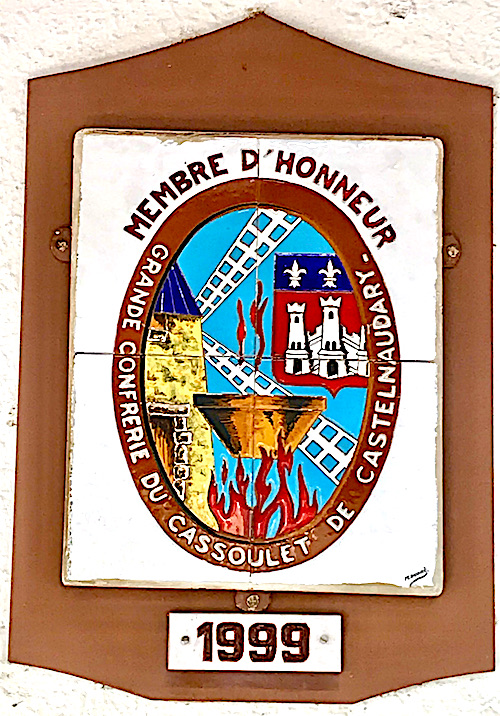
I began in Toulouse which is the cultural center of the Languedoc. I dined at Maison Du Cassoulet, which is a local favorite founded in 1956. I was immediately struck at how different Cassoulet was here compared to the recipes I had followed previously. There were no signs of any tomatoes or bread crumb toppings, the pork sausage was in one piece (rather bite size pieces) and quite mild, and the broth surrounding the beans was very rich and almost clear. In fact, this was the case with every cassoulet I ate, and I tried a bunch! Maison Du Cassoulet also has locations in Castelnaudary and Carcassonne. Delicious isn’t even a good enough word. They gave me a really cool hat.

The next day, it was a quickie train ride to Castelnaudary – the birthplace of Cassoulet! After a hike from the train station, I had a wonderful Cassoulet at Le Centre Restaurant, in the heart of the small historic village. This establishment was more elegant than Maison Du Cassoulet, and their offering was excellent. It was rich and hearty, and the “crust” on top of their Cassoulet was magnificent.
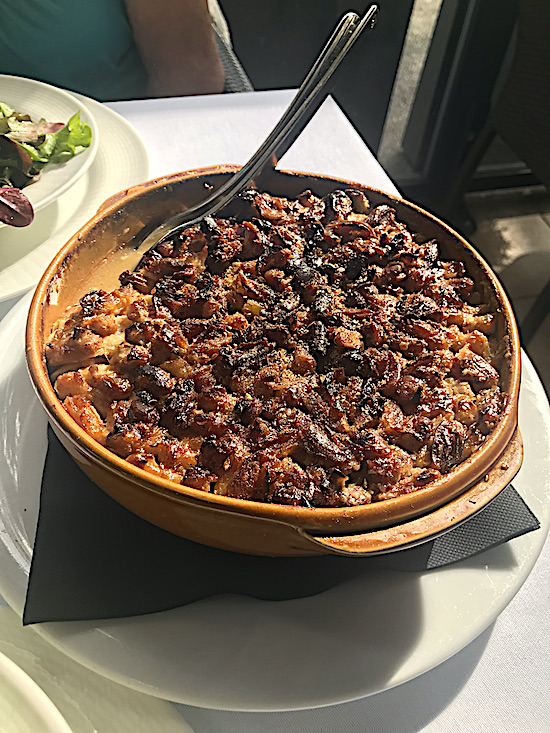
Carcassonne is a simply amazing city, just a stone’s throw down the tracks from Castelnaudary. It’s a community within the walls of a huge medieval fortress and castle on a hilltop. On this evening, it was Adelaide, a famous Cassoulet restaurant I’d sought out before my trip. It was inside the walls of the fortress, and words can’t describe Carcassonne or it’s charm. Their Cassoulet was presented a little differently than the previous ones, with the duck confit and sausage floated on top of the casserole. It was spectacular. And delicious.
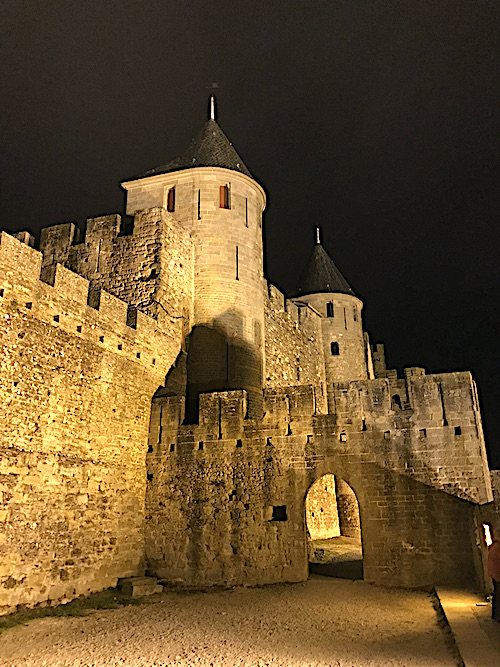
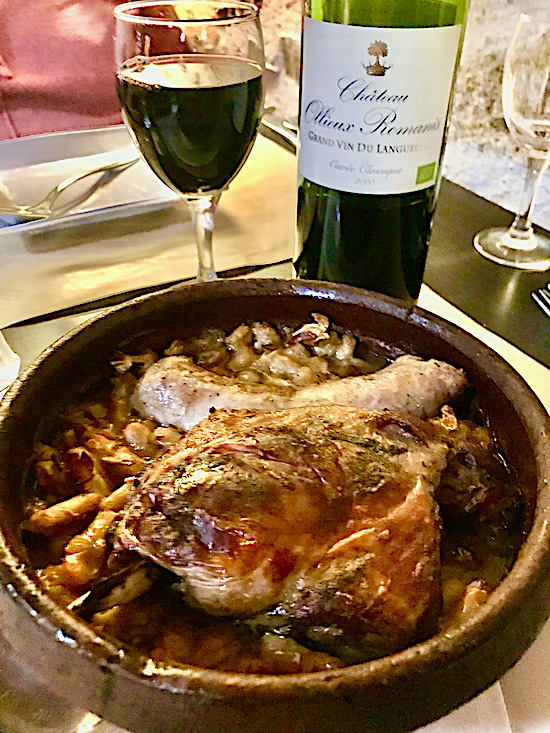
Then there was the Cassoulet at La Trivalou, a tiny cafe in Carcassonne. Before my trip, I researched the best restaurants for Cassoulet, and this was touted to be the best in the Languedoc by multiple websites. And it was! Just under the drawbridge of the majestic castle, this little restaurant was all about the chef, and nothing else. The ambience was so-so, it was a small cafe where the food did all of the talking!
The starter was delicious yet untraditional escargot in cauliflower, and the Cassoulet was not only visually stunning, it was the tastiest by far. Chef Cyril Requi spent time talking to me,
and although there were language challenges (I don’t speak French), I did understand what he was saying. I have read recipes that say you need to cook Cassoulet for 3 days, breaking the “crust” a minimum of seven times. The last time I tried that, it tasted burnt, but I wasn’t using duck fat or duck stock, and my oven was too hot. Honestly, I really didn’t know what I was trying to create. Requi says that after the Cassoulet is assembled, cook it at two hours at a simmer max. He also said something about adding foie gras, but I didn’t completely understand. The thing about the La Trivalou Cassoulet that set it apart from the others is that it’s flavors were focused, clean, super pronounced and it was so creamy.
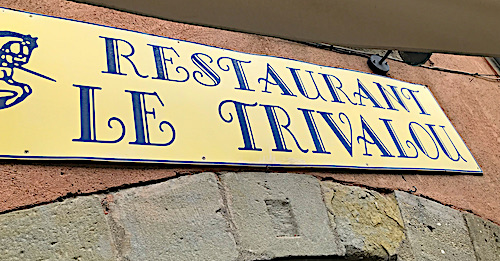
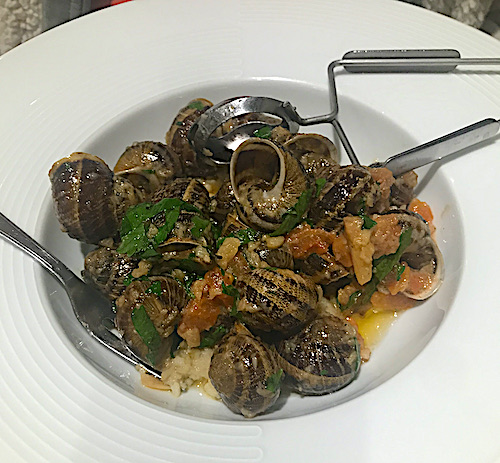
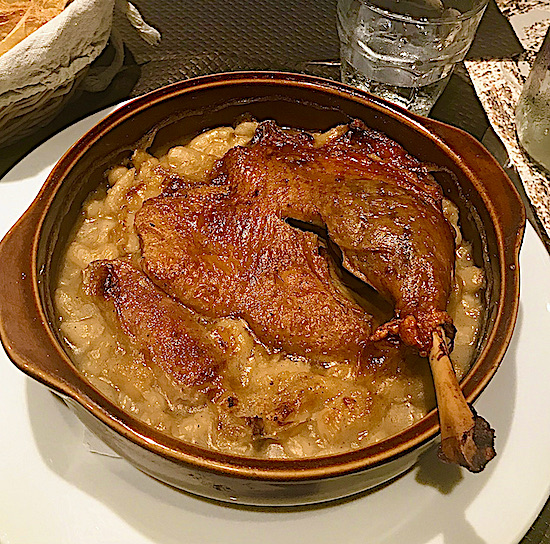
Online domestic websites and recipes (including the Julia Child’s version of Cassoulet) call for ingredients I didn’t see in Languedoc Cassoulets: tomatoes, bread crumbs (to create a fake crust), spicy sausage, chicken, salami (?), beef and beef sausage. I’ve seen recipes that call for chorizo, bacon, etc. No wonder my previous attempts didn’t quite have it!
Cassoulet might be made with goose, pork shoulder or partridge, but all of the Cassoulets I had in “the home of Cassoulet” included the same main ingredients: very mild Toulouse style sausage served in one piece, duck confit, duck stock, rendered duck fat, salt pork lardons (not bacon), Tarbais beans, carrot, onion, celery, etc.
All of that said, I am not a soup Nazi. If you are thinking about making Cassoulet, it is a peasant dish, and wide open to improvisation. Here, I am only trying to understand the dish in its purity, and share my experience. I mentioned above I’ve been attempting to make cassoulet for years before this trip, and they were mostly all wrong but each uniquely delicious.
Recipes I have followed in the past called for the wrong sausage. Julia Child’s cassoulet calls for Kielbasa or Chorizo, and both are too spicy for “traditional” cassoulet. Toulouse style sausage is not available locally in Sonoma or online. In the past, I’ve used mild Italian sausage, but the fennel, basil, paprika and other spices have clashed with the Cassoulet. The only ingredients in Toulouse sausage are ground pork, pork belly, garlic, pepper and a small pinch of nutmeg. With Toulouse sausage, the meat flavors shine, rather than the heavy dose of seasonings found in other sausages. I asked Jeremy, the butcher at Sonoma Market what he recommended, and I sure didn’t expect the answer he gave me: “Make it yourself!” So, with a few tips from him, I did exactly that with a $10 sausage stuffer from Amazon and a couple Youtube tutorials. There’s a first time for everything!
If you are up to making your own Toulouse sausage (it’s not very hard or expensive), there is a good recipe here. I found that this recipe made way more sausage than I needed, so I suggest cutting it in half. Ask your local butcher to grind the pork and pork belly coarsely: https:www//honest-food.net/toulouse-sausage-recipe/
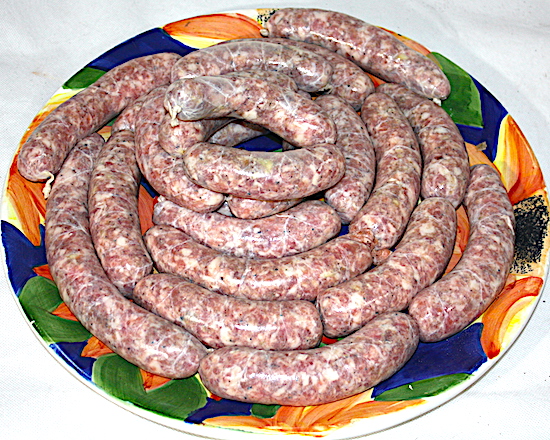
Presentation is important, and finding the correct dish for Cassoulet isn’t easy. The “cassolle” terra cotta dish is the right one. They don’t exist in the US for under $50, mostly from artisan potters. Le Creuset and others make Cassoulet bowls. They aren’t traditional, but pretty. Chef Cyril Requi (Le Trivalou) sent me home with two authentic bowls from his restaurant. In Languedoc, brown earthenware oven-safe bowls are used, but go with what you have!
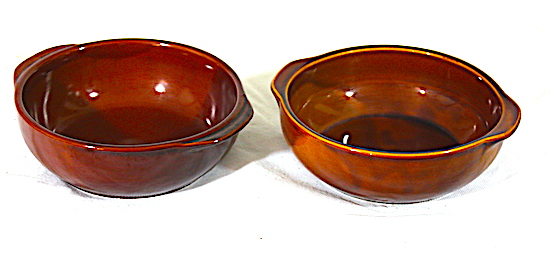
After this enjoyable and eye opening visit to the Languedoc, I once again attempted to create Cassoulet, but this time, I had a focussed understanding of what I was aiming for, both flavor-wise and visually. I did face some ingredient problems: Toulouse style sausage I discussed above. Traditional Tarbais beans are available online here for $20 per pound. I used great northern beans and saved $19. Duck stock is not available here. I purchased a duck carcass from a local duck company and made my own. If not for the duck company, I would have used chicken stock, which is do-able. Duck confit is available at upscale grocers, along with duck legs. Prepared confit is expensive, so I bought the duck legs and did the confit myself. Instructions are online.
The “crust” on the top of Cassoulet is part of its magic, and no, contrary to American urban myth, it’s not done with bread crumbs. The crust is the gelatinous part of the stock, which rises to the top when cooked. It’s easy to achieve this crust, even if you are using store-bought chicken stock. The crust comes from slow cooking. Part of the Cassoulet tradition is cooking, then refrigerating overnight, and cooking again. This allows the crust and melded flavors to develop.
This time, I tried to do it right. The results were spectacular, and the flavor was exactly what I reminisce from France! You’ll never catch me preparing a Cassoulet with tomatoes, spicy sausage or beef, and I’ll NEVER add bread crumbs to the top, ever (again). Promise!
Enjoy Cassoulet on a blustery or cold evening with a green salad, a baguette and a Languedoc wine. See Kerry’s Grapelive.com wine suggestions below.
Cassoulet does take time and patience to make. Plan on a couple days, though for most of this, you won’t have to babysit it. As with most French recipes, cutting corners only diminishes the shine. If you do make it, don’t rush it!
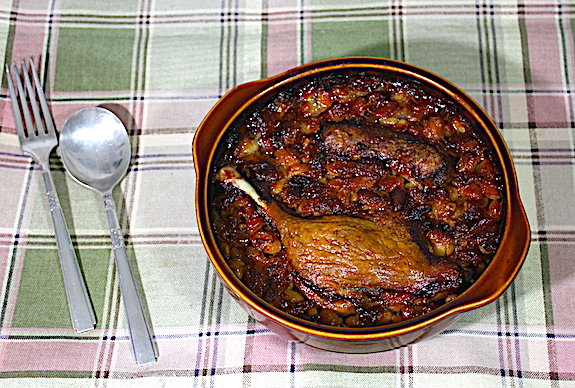
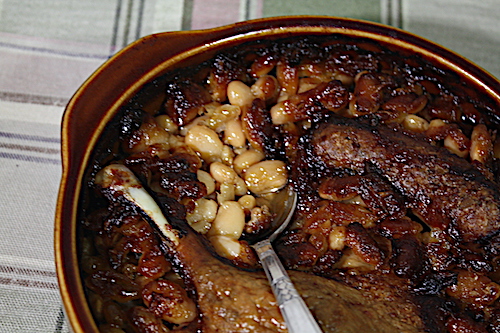
Grapelive Cassoulet Wine Suggestions
There are many fantastic Languedoc wines from which to chose and here are some of my favorite reds to enjoy with these hearty and rustic traditional Cassoulet dishes. -Kerry Winslow, grapelive.com
Wines
Chateau La Roque, Pic St Loup “Cuvee les Vieilles Vignes de Mourvedre” Languedoc, France.
Chateau La Roque is one of my favorite producers and I have long admired the quality and soul found in their wines, especially this 100% Mourvedre red from Pic Saint Loup. This richly textured and deeply colored wine is super lavish and ripely flavored with an explosion of black and red fruits on the palate along with chewy tannins, mineral and wild herbs. The extroverted special Mourvedre cuvee from Chateau La Roque is mouth filling and hedonistic from start to finish and has a real Bandol like feel and even hints at Chateauneuf-du-Pape, making for a most pleasing red that way over delivers for the price. The palate flowers deep with blackberry, cherry liqueur, blueberry and plum fruit, touches of pepper, cassis and a sweet and savory meaty element. The finish is amazingly long and fruit driven to the end, while touches of burnt earth, garrigue and dried flowers add complexity. -Kermit Lynch ($26)
Clos Marie, Metairies du Clos, Pic Saint Loup, Vieilles Vignes, Languedoc, France.
This rare and deeply flavored Grenache and Syrah blend from Clos Marie is a rival for many a Chateauneuf and or Gigondas with wonderful pure fruit, spice and mineral essences to put a smile on any Rhone lovers face. The Metairies comes from very old vines, all biodynamic, on clay and limestone soils that maximize that impact of the fruit, handcrafted and artisan made this is a spectacular wine of quality and style. The nose has earth, flowers and sweet herbs to start with fresh berries and exotic liqueur notes leading to a dense and dramatic palate of dark fruits, cracked pepper, violets and chalky stones with boysenberry, plum, fig and plum along with hints of cassis, saline, peppercorns, truffle and black licorice. While rich and intense this red has plenty of juicy acidity to keep things fresh and vivid, this is beautiful stuff, especially with classic Cassoulet. -Beaune Imports ($30)
Chateau de Lascaux “Carra” Pic Saint Loup, Coteaux du Languedoc Rouge, France.
Jean-Benoît Cavalier’s Chateau de Lascaux is a wonderful domaine in the heart of the Midi, tucked in the foothills of the Cevennes mountain range in the Languedoc, where remarkable wines are made, including this beautiful cuvee Carra made from 60% Syrah and 40% Grenache, grown on limestone soils within the Pic Saint Loup area. Lauscaux’s whites are terrific as well, these are all exotic and flavor filled wines of quality, character and distinction, with this year’s Carra being one of my favorites, it shows ripe fruit, mineral intensity and a savory tone along with textural charm and density, finishing with vivid clarity. The added details of garrigue, licorice and pepper add style and the core boysenberry, blueberry, pomegranate and raspberry fruits hit all the right notes, as well as background notes of warm earth, chalk and kirsch that highlight the terroir and complexity in this pleasure driven red. The Syrah really adds power and substance in this vintage, while the Grenache adds a heady hedonism that is seductive, this is a positively a drink now wine that oozes sex appeal. -Kermit Lynch ($24)
Maxime Magnon, Rozeta, Corbieres Rouge, Languedoc-Roussillon, France.
Magnon is an all natural producer is the wilds of the Languedoc in Vallee du Paradis and he crafts wines from field blend vineyards in Corbieres. These are beautiful, almost delicate wines, all organic and without the addition of sulfur, he learned his winemaking at the famed Morgon cellar of Jean Foillard and has been mentored also by Didier Barral in Faugeres. Maxime uses native yeasts and used Chassagne-Montrachet barrels to make his wines, the grapes are fermented whole cluster and all are co-fermented, the blend in this gorgeous Rozeta Corbieres is unique with varietals that include Carignan, Grenache and Syrah, but also has Grenache Gris, Macabou and Terret which are grayish and white grapes that add acidity, pigment and are in a way like Cote-Rotie is with the Syrah and Viognier. The soils part a part in the character in Magnon’s wines with limestone and schist adding complexity, mineral and spicy notes to these wonderfully textured and vibrant expressions of terroir. Wild strawberry and vine picked red berries which together with stemmy savory tones, spice and lavender make this a lovely wine all year long! -Kermit Lynch ($49)
Mas de Daumas Gassac, Haute Vallee du Gassac Rouge, Vin de Pays de L’Herault, Languedoc, France.
The Guibert family’s Mas de Daumas Gassac Grand Vin Rouge is a unique Bordeaux driven blend made from about 80% Cabernet Sauvignon along with about 20% of other grapes which could include Merlot, Cabernet Franc, Syrah, Tannat, Petit Verdot, Malbec, Pinot Noir, with later vintages having some Dolcetto and even some Nebbiolo. Founded in 1971 Mas de Daumas Gassac is set on iron rich red soils in a glacial formed valley in the Saint-Guilhem-le-Désert – Cité d’Aniane area of the L’Herault region of the Languedoc, it’s one of the most iconic estates of the south of France making this unique Red as well as also their equally unique and famous White that is mostly Petit Manseng, Viognier, Chardonnay and Chenin Blanc. The Guibert family now led by Samuel Guilbert, son of legendary Aimé Guibert who planted Cabernet Sauvignon from the Bordeaux’s Medoc. Each vintage is slightly different but always dark, rustic and powerful, needing robust cuisine to bring out its best, with Cassoulet being a wonderful companion to this Languedoc Grand Cru! -Beaune Imports ($65)
Traditional Cassoulet de Castelnaudary Recipe -By Bradley Gray
(Serves 4)
Ingredients:
1 pound great northern beans (Tarbais beans if you can find them)
1 quart duck stock (or chicken stock w/ 2 packets unflavored gelatin)
7 ounces salt pork
3 tablespoons Rendered Duck Fat
4 Toulouse Sausages
4 Duck Confit Legs
1 Onion
2 Carrots
2 Celery Stalks
2 Bay Leaves
10 Peppercorns
10 Whole Cloves
8 Garlic Cloves
4 Parsley Sprigs (including stems)
4 Thyme Sprigs
Day 1
Soak the beans overnight in cold water. Check periodically to make sure the beans are covered in water, as they do absorb.
Day 2
Drain water from soaked beans. Put beans in a Dutch oven or large pot, cover with cold water, bring to a boil, drain water, set beans aside.
If using store bought chicken stock instead of duck stock, place chicken stock in a bowl and add 2 packets of unflavored powdered gelatin.
Cut salt pork into 1/2 inch cubes.
Heat rendered duck fat over high heat in dutch oven. Add salt pork cubes and brown on all sides. Remove salt pork cubes with a slotted spoon and set aside.
Add sausages to fat and brown on all sides. Transfer to bowl with salt pork. If using chicken instead of duck confit, brown the chicken too. Transfer to bowl with sausage and salt pork.
Reduce heat and add the finely chopped onion and cook until translucent.
Wrap all of the bouquet garni items (2 carrots cut into thirds, 2 celery sticks cut into thirds, 2 bay leaves, 10 peppercorns, 8 garlic cloves, peeled but not chopped, 10 whole cloves, 4 large parsley sprigs including stems, 4 thyme sprigs) in a cheesecloth packet, as it will all be removed later. I find that a large clean tube sock is a nice substitute for cheesecloth. Tie it off when all ingredients are in. I told you this is a peasant dish!
Add bouquet garni, beans and stock to the Dutch oven. Bring to a boil, reduce heat and simmer uncovered for 45 minutes, flipping the bouquet garni several times to incorporate flavor.
Remove and discard bouquet garni and stir to blend flavors.
If you are using cassole or oven safe individual bowls: Assemble the Cassoulet in individual oven safe serving bowls if you plan to serve it that way. Each bowl should contain 1/4 of the lardons, placed in the bottom of the bowl, beans, 1 sausage and 1 confit, skin side up. The sausage and confit should be visible on the surface.
If you are serving from the Dutch oven: Add lardons, sausages and duck confit, skin side up, keeping the sausage and confit visible on the surface.
Place in 280 degree oven, uncovered until a crust forms on the surface (about two hours). Make sure the beans are staying covered, as you will need to add a little water or broth periodically, carefully to the side, so it flows into the casserole, not over the crust.
Note: At this point, if you would like to refrigerate, you may. It will hold for several days in the fridge. Before continuing, allow it to come back to room temperature. Part of the tradition of Cassoulet is to cook it, allow it to cool, and then cook it again.
Day 3
If refrigerated, bring back to temp in a 280 degree oven.
“Break” the crust every 30 minutes for the next 4 hours and allow underneath liquid to flow over the crust (jiggle the pot or cassole).
At the 4 hour mark, stop breaking the crust. Continue cooking for another hour.
Serve immediately, bubbling hot.
Bradley Gray, Special Contributor to Grapelive.com
Bradley is a 27-year wine industry public relations professional and journalist.
His journalism background covers wine, rock and roll and automobile racing. His weekly wine columns have appeared in The Sonoma Valley Sun and Marin Scope Newspapers. He was the Sonoma Valley Regional Correspondent for Appellation America. In addition, his work has appeared in The Wine Spectator, Grapevine Magazine, Vogue, CineSource Magazine, Grapelive.com, Quilter’s Newsletter Magazine, Sonoma Magazine, Vintage Guitar Magazine, Dot.Direct Magazine, Viansa At Home Magazine, FineLife Magazine, The Sonoma Index-Tribune, Weekender Magazine, Leeds Guide Weekly (U.K.), Patchwork Tsushin Magazine (Japan) and others.
Bradley owns Gray Matters Communications, a wine business PR firm.
In his personal life, he enjoys collecting vintage wristwatches, automobile racing, antiquing and bicycling.
All photos were taken by Bradley Gray, used here by permission, all rights reserved.
Bradley can be reached at: bradley@vom.com
